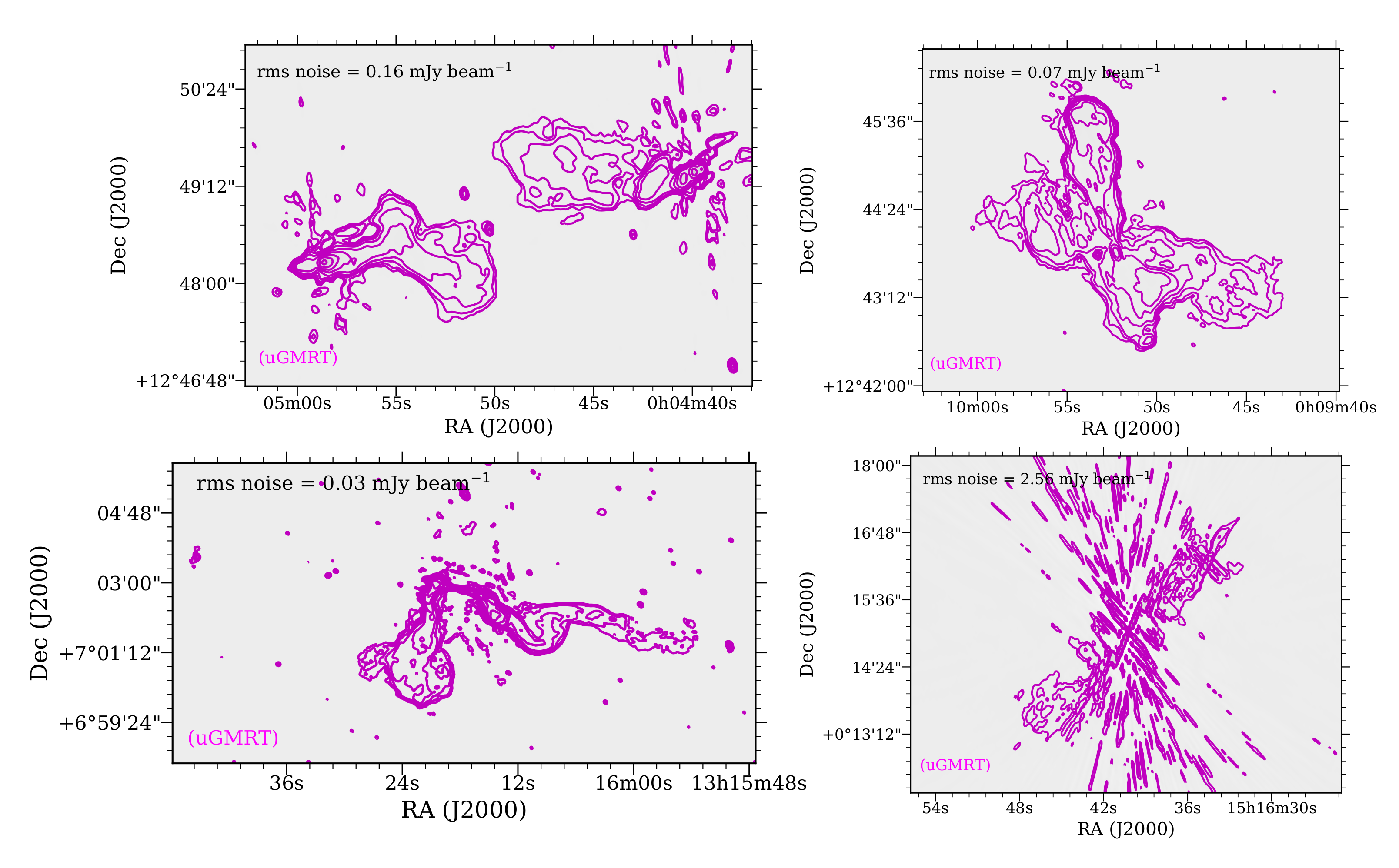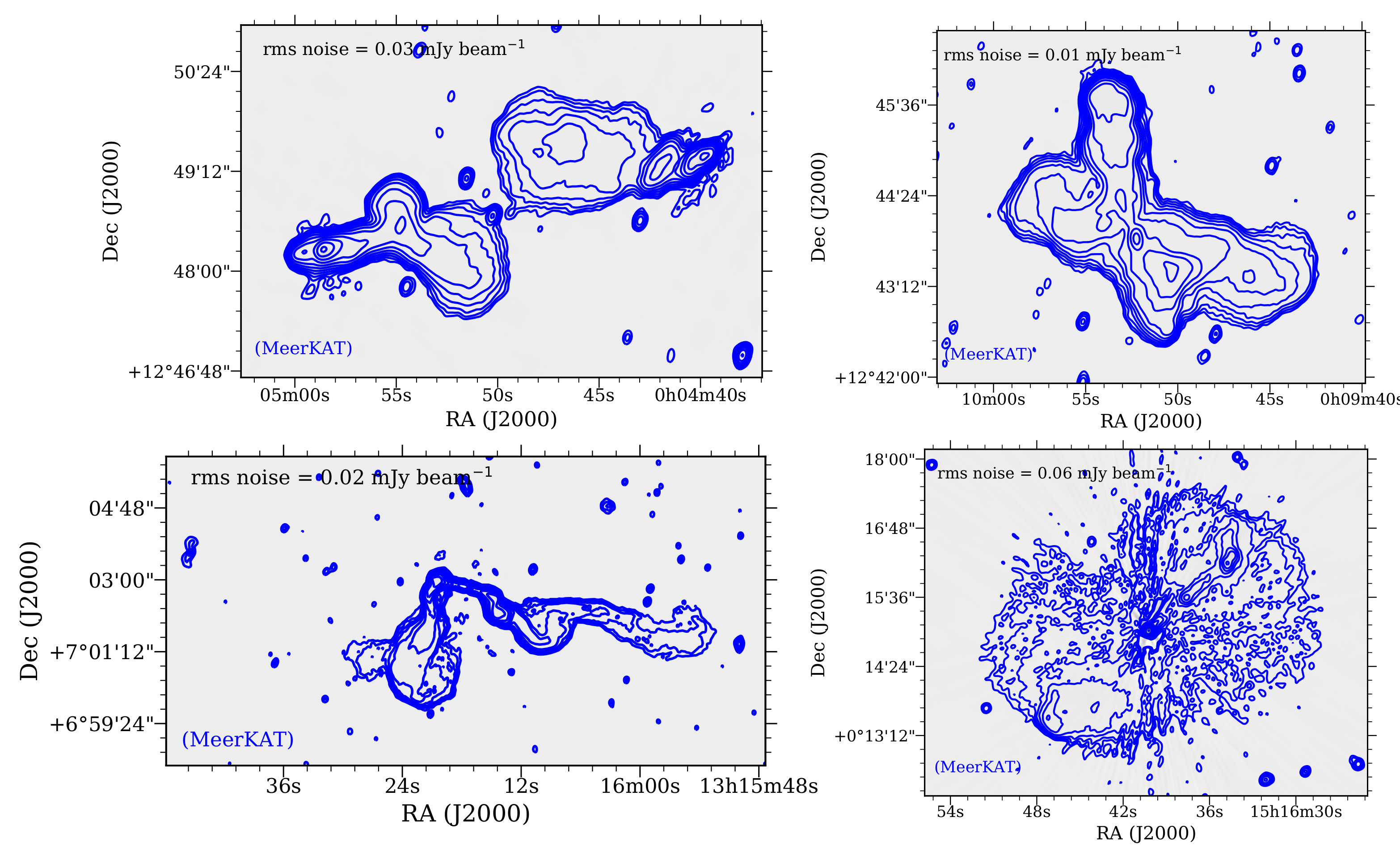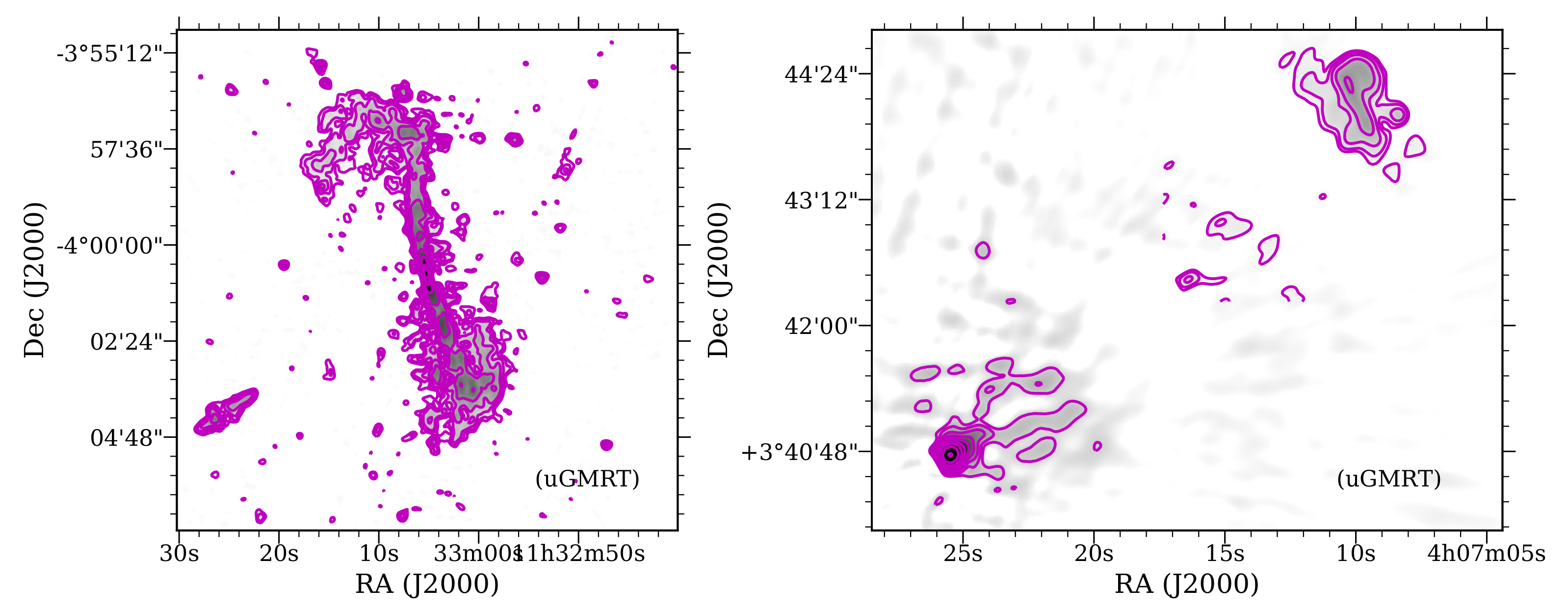Viewing Classical Radio Galaxies with the Upgraded GMRT and MeerKAT—A Progress Report
Abstract
:1. Introduction
- (1)
- Several radio galaxies (e.g., Centaurus A, M 87, NGC 1275, etc.) have been well studied in radio, infrared, optical, X-ray, and -rays (e.g., Centaurus A: [3,4,5]). They have been detected from radio to TeV -rays, and also have been studied as high-nutrino and ultra-high energy cosmic-ray potential emitters [6]. These studies propose a leptonic and hadronic model to explain the broadband spectral energy distribution spectrum in them (see also [7] and references therein).
- (2)
- FR I radio galaxies (radio powers, P < W Hz at 1.4 GHz) with their symmetric prominent jets and lobes, are known to be associated with the low excitation emission line galaxies [8,9]. Departures from the straight FR I radio morphology, are common for optical hosts in galaxy clusters, where the radio jets are exposed to a combination of effects, e.g., galaxy motion through the intracluster medium and “cluster weather” [10], and often form spectacular tailed radio galaxies [11].
- (3)
- FR II radio galaxies (P > W Hz at 1.4 GHz) are again well known to be associated with large diffuse, double lobes and bright hot spots. The nuclear activity of the optical host usually shows high excitation emission lines [8,9]. The jets of these sources are often asymmetric, and the lobes are the result of backflow from the hot spots.
- (4)
- It is commonly stated that FR I preferentially reside in dense environments, such as clusters and groups of galaxies, whereas FR II are found in less dense environments. Note the famous FR II radio galaxy, Cygnus-A, an exception, is in a galaxy group [12].
- (5)
- FR II radio galaxies populate the Universe to much larger redshifts than FR I radio galaxies [12], which is believed to be partly due to selection effects related to the sensitivity and resolution of the radio interferometers used in surveys. This paradigm is clearly expected to change with the advent of new surveys in the 0.5–2 GHz range, e.g., EMU and superMIGHTEE using ASKAP and uGMRT-MeerKAT, respectively.
- (6)
- The propagation of radio jets of FR I radio galaxies in an external medium is used to explain its morphology and jet broadening [13,14]. VLBI studies show that jets of both, FR I and FR II radio galaxies are relativistic (i.e., [15,16]). However, jets in FR I decelerate closer to the core than jets in FR II, possibly due to differences in their environments.
- (7)
- Last but not least, a new class of low power radio galaxies has been recently characterized, the so-called FR 0 [17]. The radio power of these sources is typical of FR I radio galaxies; however, they are compact on the scale of few arcseconds. High sensitivity observations at high angular resolution show that some of them have double-sided jets on very small angular scales, but many remain compact.
- (1)
- Does the “simple” FR I/FR II classification of morphology still hold up in the era of arrays with very high dynamic range?
- (2)
- Does very low surface brightness diffuse radio emission beyond the known boundaries of radio galaxies exist that is associated with the radio galaxy itself?
- (3)
- Is it possible that the dominant FR I/FR II classification holds for the current cycle of activity, but low surface brightness emission has been blown away by winds or buoyancy into more complex (and so far missed) shapes?
- (4)
- What is the nature of FR 0, and how do they fit into the overall classification?
2. Sample Selection
- (i)
- Is hosted by a detected optical galaxy;
- (ii)
- Has spectroscopically determined redshift z, and 0.05 0.20; thereby to (i) have a similar fraction of FR Is and FR IIs and to (ii) ensure detection of Mpc scale extended emission using uGMRT 550-850 MHz band (band-4);
- (iii)
- Is in the declination range [−10: +20], to ensure comparable ()-coverages and visibility with both, uGMRT and MeerKAT arrays; and
- (iv)
- Has a clear double radio morphology at the (45) angular resolution of the NRAO VLA Sky Survey (NVSS: [22]).
3. Observations and Data Reduction
4. Results
4.1. The Past
4.1.1. Radio Morphology
4.1.2. CGCG 044–046
4.2. The Present
4.3. The Future
5. Conclusions
Author Contributions
Funding
Institutional Review Board Statement
Informed Consent Statement
Data Availability Statement
Acknowledgments
Conflicts of Interest
| 1 | https://naps.ncra.tifr.res.in/goa/data/search[naps.ncra.tifr.res.in], 26 October 2021. |
| 2 | https://archive.sarao.ac.za[archive.sarao.ac.za], 26 October 2021. |
References
- Fanaroff, B.L.; Riley, J.M. The morphology of extragalactic radio sources of high and low luminosity. Mon. Not. R. Astron. Soc. 1974, 167, 31P–36P. [Google Scholar] [CrossRef] [Green Version]
- Blandford, R.; Meier, D.; Readhead, A. Relativistic Jets from Active Galactic Nuclei. Annu. Rev. Astron. Astrophys. 2019, 57, 467–509. [Google Scholar] [CrossRef] [Green Version]
- Fraija, N.; Aguilar-Ruiz, E.; Galván-Gámez, A.; Marinelli, A.; de Diego, J. Study of the PeV neutrino, γ-rays, and UHECRs around the lobes of Centaurus A. Mon. Not. R. Astron. Soc. 2018, 481, 4461–4471. [Google Scholar] [CrossRef]
- Hardcastle, M.J.; Worrall, D.M.; Kraft, R.P.; Forman, W.R.; Jones, C.; Murray, S.S. Radio and X-Ray observations of the jet in Centaurus A. Astrophys. J. 2003, 593, 169–183. [Google Scholar] [CrossRef]
- Hardcastle, M.J.; Croston, J.H. Radio galaxies and feedback from AGN jets. NewAR 2020, 88, 1539–1581. [Google Scholar] [CrossRef]
- Fraija, N.; Marinelli, A. Neutrino, γ-ray, and cosmic-ray fluxes from the core of the closest radio galaxies. Astrophys. J. 2016, 830, 81–93. [Google Scholar] [CrossRef] [Green Version]
- IceCube Collaboration. Evidence for high-energy extraterrestrial neutrinos at the IceCube detector. Science 2013, 342, 1–38. [Google Scholar]
- Best, P.N.; Heckman, T.M. On the fundamental dichotomy in the local radio-AGN population: Accretion, evolution and host galaxy properties. Mon. Not. R. Astron. Soc. 2012, 421, 1569–1582. [Google Scholar] [CrossRef] [Green Version]
- Heckman, T.M.; Best, P.N. The Coevolution of Galaxies and Supermassive Black Holes: Insights from Surveys of the Contemporary Universe. Annu. Rev. Astron. Astrophys. 2014, 52, 589–660. [Google Scholar] [CrossRef] [Green Version]
- Burns, J.O.; Hanisch, R.J.; White, R.A.; Nelson, E.R.; Morrisette, K.A.; Moody, J.W. A VLA 20 cm Survey of Poor Groups of Galaxies. Astron. J. 1987, 94, 587–809. [Google Scholar] [CrossRef]
- Lal, D.V.; Rao, A.P. 3C 129: The GMRT observations. Astron. Astrophys. 2004, 420, 489–491. [Google Scholar] [CrossRef] [Green Version]
- Hardcastle, M.J. Jets, hotspots and lobes: What X-ray observations tell us about extragalactic radio sources. Phil. Trans. R. Soc. 2005, 363, 2711–2727. [Google Scholar] [CrossRef]
- Bicknell, G.; Jones, D.L.; Lister, M. Relativistic jets. NewAR 2004, 48, 1151–1155. [Google Scholar] [CrossRef]
- Laing, R.A.; Bridle, A.H. Relativistic jet models for two low-luminosity radio galaxies: Evidence for backflow? Mon. Not. R. Astron. Soc. 2012, 424, 1149–1169. [Google Scholar] [CrossRef] [Green Version]
- Giovannini, G.; Cotton, W.D.; Feretti, L.; Lara, L.; Venturi, T. VLBI Observations of a Complete Sample of Radio Galaxies: 10 Years Later. Astrophys. J. 2001, 552, 508–526. [Google Scholar] [CrossRef] [Green Version]
- Venturi, T.; Castaldini, C.; Cotton, W.D.; Feretti, L.; Giovannini, G.; Lara, L.; Marcaide, J.M.; Wehrle, A.E. VLBI Observations of a Complete Sample of Radio Galaxies. VI. The Two FR I Radio Galaxies B2 0836+29 and 3C 465. Astrophys. J. 1995, 454, 735–762. [Google Scholar] [CrossRef] [Green Version]
- Baldi, R.D.; Capetti, A.; Giovannini, G. High-resolution VLA observations of FR0 radio galaxies: The properties and nature of compact radio sources. Mon. Not. R. Astron. Soc. 2019, 482, 2294–2304. [Google Scholar] [CrossRef] [Green Version]
- Hardcastle, M.J.; Croston, J.H.; Shimwell, T.W.; Tasse, C.; Gürkan, G.; Morganti, R.; Murgia, M.; Röttgering, H.J.A.; van Weeren, R.J.; Williams, W.L. NGC 326: X-shaped no more. Mon. Not. R. Astron. Soc. 2019, 488, 3416–3422. [Google Scholar] [CrossRef]
- Ramatsoku, M.; Murgia, M.; Vacca, V.; Serra, P.; Makhathini, S.; Govoni, F.; Smirnov, O.; Andati, L.A.L.; De Blok, E.; Józsa, G.I.G.; et al. Collimated synchrotron threads linking the radio lobes of ESO 137-006. Astron. Astrophys. 2020, 636, L1–L5. [Google Scholar] [CrossRef]
- Schellenberger, G.; Vrtilek, J.M.; David, L.; O’Sullivan, E.; Giacintucci, S.; Johnston-Hollitt, M.; Duchesne, S.W.; Raychaudhury, S. NGC 741–Mergers and AGN Feedback on a Galaxy-group Scale. Astrophys. J. 2017, 845, 84–97. [Google Scholar] [CrossRef] [Green Version]
- Pilkington, J.D.H.; Scott, P.F. A survey of radio sources between declinations 20 ∘ and 40 ∘. Mem. R. Astron. Soc. 1965, 69, 183–224. [Google Scholar]
- Condon, J.J.; Cotton, W.D.; Greisen, E.W.; Yin, Q.F.; Perley, R.A.; Taylor, G.B.; Broderick, J.J. The NRAO VLA Sky Survey. Astron. J. 1998, 115, 1693–1716. [Google Scholar] [CrossRef]
- Gupta, Y.; Ajithkumar, B.; Kale, H.S.; Nayak, S.; Sabhapathy, S.; Sureshkumar, S.; Swami, R.V.; Chengalur, J.N.; Ghosh, S.K.; Ishwara-Chandra, C.H.; et al. The upgraded GMRT: Opening new windows on the radio Universe. Curr. Sci. 2017, 113, 707–714. [Google Scholar] [CrossRef]
- Swarup, G.; Ananthakrishnan, S.; Kapahi, V.K.; Rao, A.P.; Subrahmanya, C.R.; Kulkarni, V.K. The Giant Metre-Wave Radio Telescope. Curr. Sci. 1991, 60, 95. [Google Scholar]
- Jonas, J.; MeerKAT Team. The MeerKAT Radio Telescope. MeerKAT Sci. Pathw. SKA 2016, PoS, 1–22. [Google Scholar]
- Lehmensiek, R.; Theron, I.P. On reflector feeds with unidirectional axially symmetric radiation patterns: Their cross-polarization performance and efficiencies. In Proceedings of the 31st URSI General Assembly and Scientific Symposium (GASS), Beijing, China, 16–23 August 2014; pp. 1–4. [Google Scholar]
- Lehmensiek, R.; Theron, I.P. Deriving an Optimum Mapping Function for the SKA-Shaped Offset Gregorian Reflectors. In Proceedings of the International Conference Electromagnetics in Advanced Applications (ICEAA), Cape Town, South Africa, 2–7 September 2012; pp. 321–324. [Google Scholar]
- Fanaroff, B.; Lal, D.V.; Venturi, T.; Smirnov, O.M.; Bondi, M.; Thorat, K.; Bester, L.H.; Józsa, G.I.G.; Kleiner, D.; Loi, F.; et al. A new look at old friendsߞImaging classical radio galaxies with uGMRT and MeerKAT. Mon. Not. R. Astron. Soc. 2021, 505, 6003–6016. [Google Scholar] [CrossRef]
- Lal, D.V. Upgraded GMRT Observations of the Coma Cluster of Galaxies: The Observations. Astrophys. J. Suppl. Ser. 2020, 250, 22–31. [Google Scholar] [CrossRef]
- Lal, D.V.; Rao, A.P. Giant Metrewave Radio Telescope observations of X-shaped radio sources. Mon. Not. R. Astron. Soc. 2007, 374, 1085–1102. [Google Scholar] [CrossRef] [Green Version]
- Cotton, W.D.; Thorat, K.; Condon, J.J.; Frank, B.S.; Józsa, G.I.G.; White, S.V.; Deane, R.; Oozeer, N.; Atemkeng, M.T.; Bester, L.; et al. Hydrodynamical backflow in X-shaped radio galaxy PKS 2014–55. Mon. Not. R. Astron. Soc. 2020, 495, 1271–1283. [Google Scholar] [CrossRef]
- Schoenmakers, A.P.; Mack, K.H.; De Bruyn, A.G.; Röttgering, H.J.A.; Klein, U.; Van Der Laan, H. A new sample of giant radio galaxies from the WENSS survey. II. A multi-frequency radio study of a complete sample: Properties of the radio lobes and their environment. Astron. Astrophys. 2000, 146, 293–322. [Google Scholar] [CrossRef]
- Ramatsoku, M.; Verheijen, M.A.W.; Kraan-Korteweg, R.C.; Jarrett, T.H.; Said, K.; Schröder, A.C. A near-infrared study of the obscured 3C129 galaxy cluster. Astron. Astrophys. 2020, 644, 107–139. [Google Scholar] [CrossRef]
- Hurley-Walker, N.; Callingham, J.R.; Hancock, P.J.; Franzen, T.M.O.; Hindson, L.; Kapińska, A.D.; Morgan, J.; Offringa, A.R.; Wayth, R.B.; Wu, C.; et al. GaLactic and Extragalactic All-sky Murchison Widefield Array (GLEAM) survey - I. A low-frequency extragalactic catalogue. Mon. Not. R. Astron. Soc. 2017, 464, 1146–1167. [Google Scholar] [CrossRef] [Green Version]
- White, S.V.; O Franzen, T.M.; Riseley, C.J.; Wong, O.I.; Kapińska, A.D.; Hurley-Walker, N.; Callingham, J.R.; Thorat, K.; Wu, C.; Hancock, P.; et al. The GLEAM 4-Jy (G4Jy) Sample: I. Definition and the catalogue. Publ. Astron. Soc. Aust. 2020, 37, 18–74. [Google Scholar]
- White, S.V.; Franzen, T.; Riseley, C.J.; Wong, O.I.; Kapińska, A.D.; Hurley-Walker, N.; Callingham, J.R.; Thorat, K.; Wu, C.; Hancock, P.; et al. The GLEAM 4-Jy (G4Jy) Sample: II. Host galaxy identification for individual sources. Publ. Astron. Soc. Aust. 2020, 37, 17–73. [Google Scholar] [CrossRef]
- Patnaik, A.R.; Malkan, M.A.; Salter, C.J. Multifrequency observations of the wide-angle tail radio source 1313+073. Mon. Not. R. Astron. Soc. 1986, 220, 351–362. [Google Scholar] [CrossRef]
- Garrington, S.T.; Leahy, J.P.; Conway, R.G.; Laing, R.A. A systematic asymmetry in the polarization properties of double radio sources with one jet. Nature 1988, 331, 147–149. [Google Scholar] [CrossRef]
- Rector, T.A.; Stocke, J.T.; Ellingson, E. Quasar Radio Morphology and Clustering Environment at z∼1/2. Astron. Astrophys. 1995, 110, 1492–1497. [Google Scholar] [CrossRef]
- Madrid, J.P.; Chiaberge, M.; Floyd, D.; Sparks, W.B.; Macchetto, D.; Miley, G.K.; Axon, D.; Capetti, A.; O’Dea, C.P.; Baum, S.; et al. Hubble Space Telescope Near-Infrared Snapshot Survey of 3CR Radio Source Counterparts at Low Redshift. Astrophys. J. Suppl. Ser. 2006, 164, 307–333. [Google Scholar] [CrossRef] [Green Version]
- Leahy, J.P.; Black, A.R.S.; Dennett-Thorpe, J.; Hardcastle, M.J.; Komissarov, S.; Perley, R.A.; Riley, J.M.; Scheuer, P.A.G. A study of FRII radio galaxies with z < 0.15—II. High-resolution maps of 11 sources at 3.6 cm. Mon. Not. R. Astron. Soc. 1997, 291, 20–53. [Google Scholar]



Publisher’s Note: MDPI stays neutral with regard to jurisdictional claims in published maps and institutional affiliations. |
© 2021 by the authors. Licensee MDPI, Basel, Switzerland. This article is an open access article distributed under the terms and conditions of the Creative Commons Attribution (CC BY) license (https://creativecommons.org/licenses/by/4.0/).
Share and Cite
Lal, D.V.; Legodi, P.; Fanaroff, B.; Venturi, T.; Smirnov, O.M.; Bondi, M.; Thorat, K.; Bester, L.H.; Józsa, G.I.G.; Kleiner, D.; et al. Viewing Classical Radio Galaxies with the Upgraded GMRT and MeerKAT—A Progress Report. Galaxies 2021, 9, 87. https://doi.org/10.3390/galaxies9040087
Lal DV, Legodi P, Fanaroff B, Venturi T, Smirnov OM, Bondi M, Thorat K, Bester LH, Józsa GIG, Kleiner D, et al. Viewing Classical Radio Galaxies with the Upgraded GMRT and MeerKAT—A Progress Report. Galaxies. 2021; 9(4):87. https://doi.org/10.3390/galaxies9040087
Chicago/Turabian StyleLal, Dharam V., Portia Legodi, Bernie Fanaroff, Tiziana Venturi, Oleg M. Smirnov, Marco Bondi, Kshitij Thorat, Landman H. Bester, Gyula I. G. Józsa, Dane Kleiner, and et al. 2021. "Viewing Classical Radio Galaxies with the Upgraded GMRT and MeerKAT—A Progress Report" Galaxies 9, no. 4: 87. https://doi.org/10.3390/galaxies9040087





